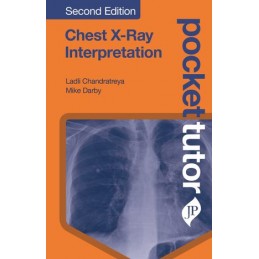- Obniżka


 Dostawa
Dostawa
Wybierz Paczkomat Inpost, Orlen Paczkę, DHL, DPD, Pocztę, email (dla ebooków). Kliknij po więcej
 Płatność
Płatność
Zapłać szybkim przelewem, kartą płatniczą lub za pobraniem. Kliknij po więcej szczegółów
 Zwroty
Zwroty
Jeżeli jesteś konsumentem możesz zwrócić towar w ciągu 14 dni*. Kliknij po więcej szczegółów
Titles in the Pocket Tutor series give practical guidance on subjects that medical students and foundation doctors need help with on the go, at a highly-affordable price that puts them within reach of those rotating through modular courses or working on attachment.
Topics reflect information needs stemming from todays integrated undergraduate and foundation courses::
The highly-structured, bite-size content helps novices combat the fear factor associated with day-to-day clinical training and provides a detailed resource that students and junior doctors can carry in their pocket.
Key points
Opis
Preface
Chapter 1 First principles
1.1 Physics of X-rays
1.2 Positioning the patient and obtaining the image
1.3 Radiographic densities
1.4 Picture archiving and communication systems:: image optimisation and pitfalls
1.5 Errors of perception and interpretation
Chapter 2 Understanding the normal chest X-ray
2.1 Normal chest anatomy
2.2 Normal variants and congenital anomalies
2.3 Artefacts
2.4 Systematic approach to reviewing the chest X-ray
2.5 Postsurgical appearances
Chapter 3 Recognising abnormal signs
3.1 Lung opacities
3.2 Atelectasis
3.3 Reticular opacities
3.4 Pleural abnormalities
3.5 Mediastinal abnormalities
3.6 Diaphragm, subdiaphragmatic area and chest wall abnormalities
Chapter 4 Thoracic infections
4.1 Community-acquired pneumonia
4.2 Hospital-acquired pneumonia
4.3 Active tuberculosis
4.4 Old tuberculosis
4.5 Pneumocystis pneumonia
4.6 Aspergilloma
4.7 Histoplasmosis
Chapter 5 Interstitial lung diseases
5.1 Sarcoidosis
5.2 Idiopathic pulmonary fibrosis
5.3 Asbestosis
5.4 Silicosis
Chapter 6 Bronchogenic malignancy and metastatic disease
6.1 Bronchogenic malignancy
6.2 Metastatic disease
Chapter 7 Pleural disease
7.1 Mesothelioma and other pleural malignancies
7.2 Solitary fibrous tumour of the pleura
7.3 Pleural infection
7.4 Pneumothorax
Chapter 8 Mediastinal disease
8.1 Thymoma
8.2 Hiatus hernia
8.3 Bronchogenic cyst
8.4 Retrosternal goitre
8.5 Pneumomediastinum
8.6 Mitral regurgitation
8.7 Pericardial effusion
8.8 Aortic dissection
Chapter 9 Airway pathology
9.1 Asthma
9.2 Allergic bronchopulmonary aspergillosis
9.3 Chronic obstructive pulmonary disease
9.4 Alpha 1-antitrypsin deficiency
9.5 Bronchiectasis and cystic fibrosis
9.6 Inhaled foreign body
Chapter 10 Pulmonary oedema
10.1 Cardiogenic pulmonary oedema
10.2 Acute lung injury and acute respiratory distress syndrome
Chapter 11 Lines, tubes and other devices
11.1 Nasogastric tubes
11.2 Central venous lines and pacemakers
11.3 Tracheal intubation
11.4 Chest drains
11.5 Other devices in the intensive care situation
11.6 Devices used in lung volume reduction
11.7 Tracheal and bronchial stents
11.8 Embolisation coils in treatment of pulmonary AVM
11.9 Thoracic aortic stent
11.10 Implantable loop recorder
11.11 Left ventricular partitioning device
11.12 Atrial septal defect closure device
11.13 Bariatric surgical treatment
11.14 Oesophageal stent
11.15 Oesophageal variceal embolisation coils
11.16 Transhepatic portosystemic shunt
11.17 Breast implants
11.18 Nipple-areolar prosthesis
11.19 Occipital nerve stimulation system
11.20 Incorrectly placed devices and pitfalls
Chapter 12 Thoracic trauma
12.1 Pneumothorax and haemothorax
12.2 Aortic and vascular injury
12.3 Chest wall injuries
12.4 Pulmonary injury
12.5 Tracheal and bronchial injuries
12.6 Oesophageal tear
12.7 Diaphragmatic rupture
12.8 Pneumoperitoneum
12.9 Penetrating injuries
12.10 Lines and tubes
Index
